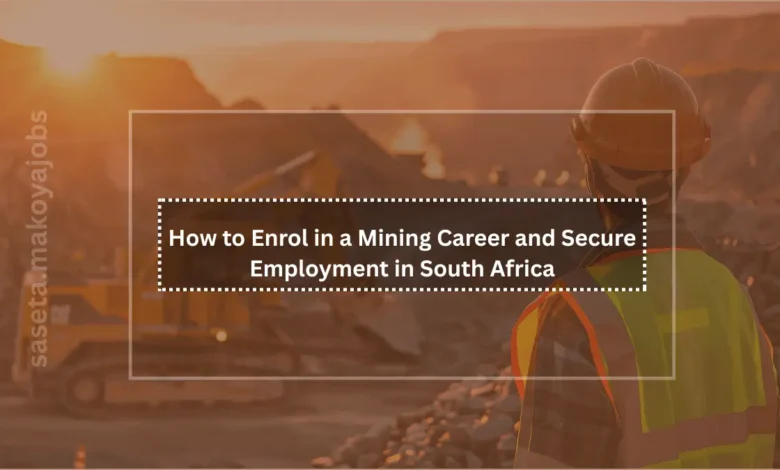How to Enrol in a Mining Career and Secure Employment in South Africa

Explore a complete step-by-step guide on how to enrol in a mining career in South Africa. Learn about training options, application tips.
If you’re considering a career in mining—whether in engineering, health & safety, metallurgy, administration, or geology—this guide will walk you through a clear, step-by-step strategy to enrol in the right training and transition into the workforce.
1. Understand Mining Careers and Your Entry Path
Mining Career Options
The mining industry offers roles spanning:
- Artisan, engineering, or mechanical technician
- Health, safety, and environmental control
- Geology, surveying, or resource planning
- Administrative, governance, and finance roles
Types of Training to Begin
Decoded entry paths include:
- SETA-backed internships or learnerships (e.g. MQA for mining and minerals)
- TVET college diplomas in mining engineering, safety, or trade (NQF Level 4–5)
- Internships or bursary‑linked programmes via corporate mining companies
- University or university of technology qualifications
Most entry roles require NQF Level 4 (Matric) or above, along with basic industry training.
2. Clarify Your Target Role and Sector
Identify a Focus
Determine a specialisation that matches your interests:
- Maintenance, mechanics, or electrical trade? Aim for technical core disciplines.
- Prefer compliance or safety? Look for Health & Safety learnerships or certificates.
- Drawn to environmental or geological aspects? Seek exposure in resource planning roles.
Research Demand
Mining SETAs issue annual gazettes or training schedules that reflect priority skills gaps—explore roles where demand (and stipend uptake) is highest.
3. Check Eligibility and Entry Requirements
Basic Eligibility
- South African citizenship or permanent residency
- At least Matric (NQF Level 4) with a good pass in math/physics or science depending on the role
- Be unemployed or under-employed, with the flexibility to train full‑time
Programme-Specific Criteria
- Health and Safety roles may require medical clearance or fitness certificates
- Technical trades may require prior N2/N3 certificates or trade theory
- Artisans often need physical dexterity and industry readiness
Review the SETA or training provider requirements carefully before applying.
4. Prepare Your Application Documents
Essential Paperwork
- Certified copy of your ID
- Matric certificate and academic transcript
- CV highlighting relevant training, volunteer, or practical skills
- Proof of residence (not older than 3 months)
- Motivation or application letter tailored to the mining role
Organize your digital files clearly (e.g., “Surname_ID.pdf”) and have them certified.
5. Find and Apply for Training Programmes
Where to Look
- Official SETA portals such as MQA (Mining Qualifications Authority)
- TVET college programmes in mining, safety, or trade operations
- Company websites or bursary portals of major mining groups (like Anglo, Sibanye, Harmony)
- Government-linked platforms such as Youth Employment Services or National Skills Fund openings
Steps to Apply
- Register on the SETA or training provider platform
- Upload documents and choose available programmes
- Apply strategically across multiple training options
- Monitor deadlines and track submission confirmations
- Be ready to respond quickly if shortlisted
6. Prepare for Interview and Assessment Stages
Expect:
- Aptitude or literacy/numeracy tests
- Interviews—prepare to discuss technical interest, safety awareness, and adaptability
- Medical or vision screenings for health and safety roles
Dress professionally, arrive early, and clearly communicate your goals and strengths.
7. Enrol, Train, and Launch Your Mining Career
Signing the Training Agreement
Once selected, you’ll sign an agreement outlining your responsibilities, stipend, training duration, and code of conduct.
Training Elements
- Classroom or online modules delivered by SETA-accredited trainers
- Structured workplace experience with a host employer in the mining sector
- Mentorship, logbook reporting, and supervisor evaluations
- Final assessments aligned to industry standards
Take initiative, ask questions, and stay punctual to prove your professionalism.
8. Complete the Programme and Prepare for Employment
Certification and Job Readiness
After completion, you receive an NQF-aligned qualification and valuable on-the-job evidence. Update your CV with:
- Qualification details (effective date and NQF level)
- Host employer name and tasks performed
- Supervisors or mentors as references
Job Applications
Submit applications to mining companies, sector agencies, or mining suppliers. Emphasize training experience and readiness to work in regulated environments.
9. Challenges You May Face—and How to Overcome Them
| Challenge | How to Manage It |
|---|---|
| Limited training slots | Apply early and submit to multiple providers |
| Document certification issues | Visit home affairs or verification offices early |
| Qualification prerequisites | Consider TVET bridging courses if math/sciences missing |
| Placement delays | Follow up politely and remain proactive in job search |
| High physical or safety demands | Train for physical readiness and take heed of safety briefings |
10. Story of Success: A Typical Pathway
Consider a fictional candidate, Thabo, who:
- Holds Matric with passes in maths and science
- Applies to MQA for an artisan programme in electrical engineering
- Completes classroom modules and a 12-month placement at a mine
- Earns certification and gains experience in maintenance tasks
- Receives a permanent technician role after program completion
This structured pathway reflects how SETA-backed training, stipend support, and workplace exposure translate into real job opportunities.
🚀 Final Thoughts: Start Today, Build Tomorrow
A mining career in South Africa offers robust employment and growth potential—and an accessible entry point is an accredited learnership, internship, or TVET course.
Summary Steps:
- Identify your preferred mining role and programme type
- Confirm eligibility and prepare certified documents
- Apply early across multiple programmes
- Prepare for assessments and interviews
- Enrol promptly, complete training with diligence
- Use certification and experience to pursue permanent opportunities
Mining is complex, but your entry doesn’t need to be. With planning, preparation, and persistence, you can begin a skilled, stable career—step by step.





